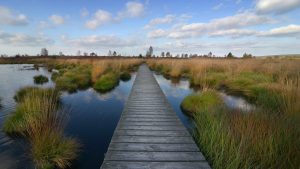Posted on May 11, 2022 by Susan M. Cooke

Recent articles in the New York Times about peatlands underscore their importance in sequestering carbon. As explained in a November 2021 publication issued by the International Union for Conservation of Nature (IUCN) and information provided by its Commission on Ecosystem Management, peatlands contain about 30% of all soil carbon – more than is stored in all other vegetation types, including the world’s forests. They also note that carbon released from disturbed peatlands represents about 5% of global anthropomorphic greenhouse gas emissions.
Peatlands range from the treeless blanket bogs of Scotland to forested tropical swamps in the Congo. Their water-logged condition slows decomposition of the dead plant material they contain, thereby sequestering the carbon that would otherwise be released to the atmosphere. That carbon is released when peatlands are drained and when permafrost peatlands thaw, such releases continuing as those peatlands dry out. Carbon is also emitted from the burning of peat and peatlands.
As depicted on maps published by the IUCN and the Wildlife Conservation Society Canada, most peatlands are found in the northern hemisphere, particularly in the boreal regions of Russia and Canada. Significant peatlands also exist in the southern hemisphere, including swamps in Indonesia and swamp forests in the Congo and South America. The large stretch of peatlands in Canada and Alaska that extend south to the northern portions of Minnesota and Michigan are primarily bogs (watered by precipitation) and fens (also receiving water from groundwater and sometimes a stream as well). The United States also has peatland swamps further south, including in Louisiana and Florida.
While the burning of peat as fuel has largely ended in developed countries, a substantial amount of it is still extracted for use in horticulture, with Canada and the United States being the world’s largest exporter and importer, respectively. In developing countries, peatlands are drained and may also be burned to create plantations for crops as in Indonesia, or to harvest valuable timber as in the Republic of the Congo.
Peatland protection is receiving greater attention since last November’s COP 26 Climate Summit where 141 government signatories, including the United States, pledged to halt and reverse forest loss and land degradation by 2030. In recent years such efforts have included restoration of damaged peatlands, such as the re-wetting of peatlands by the U.S. Fish and Wildlife Service at the Pocosin Lakes National Wildlife Refuge in North Carolina, and carbon credit programs for peatland restoration like that established in the United Kingdom. In addition, governments and nonprofit organizations are providing funds for indigenous community stewardship of peatlands, including in Borneo and Canada. More far reaching efforts are also under consideration, such as a U.K. government proposal to end retail sale of peat for horticultural use in England and Wales.
As in most countries, there appear to be no statutes or regulations in the United States that directly address carbon emissions from peatlands, and the requirements that do apply focus on protection of wetland habitat and water quality. Given this country’s differing views on climate change, new legislation to address peatland carbon emissions is likely to be “bogged down” for the foreseeable future. Perhaps the most promising avenue for addressing those emissions in the near term may be through expansion of state and local wetland jurisdiction that takes them into account during the permitting of peatland for mining or development purposes, including what restoration may be required after their disturbance. Other potential avenues for addressing peatland emissions include carbon credit programs that foster rehabilitation of disturbed peatlands and government and nonprofit funding of peatland restoration projects.
Given the recent focus on peatlands and their role in carbon sequestration, they may yet receive the attention they deserve, as so eloquently expressed in Professor Robinson’s December 1, 2016 blog. And that in turn could mean that peat will earn the moniker of climate “champ” instead of “chump”.
